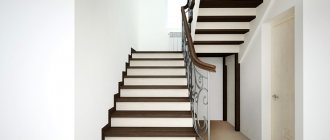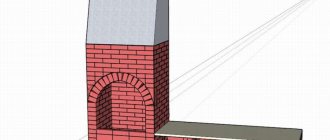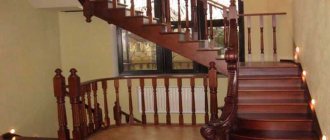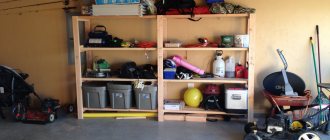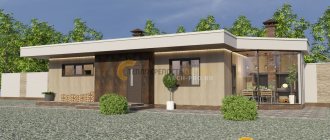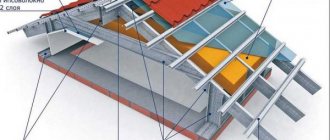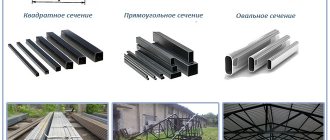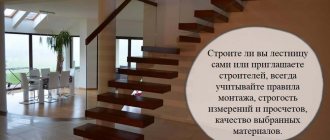Another welding option is from a corner. But to ensure the rigidity of the stairs, a large corner will be required, which means a significant waste of metal. You can use two small corners, but then they need to be welded to increase the profile of the bowstring.
No house is complete without a staircase. They are required to enter the house, to the second floor, attic or attic. Most people choose metal stairs. This is due to the advantages of the metal, its strength, durability, and the ability to give it any shape.
In addition to stationary ones, a mobile one is often required; for housework and gardening, an extension ladder or stepladder is always needed. Welding metal stairs is the best option.
Metal frame for interior stairs.
Do-it-yourself metal staircase: is it needed at all?
When talking about metal stairs, we can mean two types of structures: those made entirely of metal and stairs with metal frames. Both of them can be done on your own. What is the difference and how to choose the best option? How to weld a ladder and what is needed for this?
Stairs on metal frames are an excellent interior solution. They have a modern look, look very stylish, are quite durable and reliable, but are often more expensive compared to classic wooden ones. Only the frame of such stairs is made of metal - bowstrings or stringers. The handrail of the fence and steps are made of wood, and the vertical supports of the fence (balustrade) are optional; they can be either wooden or metal.
Metal frame for interior stairs.
But we will dwell in more detail on how to weld a ladder entirely from metal yourself. Such staircases can be used as interior ones, but it is very important to understand that metal is a “cold” material; unlike wood, it will rather bring a certain indifference and detachment into the house, helping little to create coziness. Keep this in mind if you are going to make a metal staircase to go up to the second floor in your living space.
Another thing is street stairs made of metal. They look truly impressive. But this is not the most important thing - no other type of stairs is simply suitable for outdoor use, since only steel can withstand unfavorable environmental conditions for many decades - rain, snow, low temperatures, etc. You can weld a metal staircase for the street at home conditions, and you will get a moderately expensive and fairly reliable design.
Street staircase made of metal.
Finally, another advantage of metal stairs is their highest strength, which cannot be compared even with high-quality wooden stairs.
So, let’s make a metal street staircase with our own hands!
Preparation of stringers begins with choosing a profile; the most common is a channel or an I-beam, but this is not the entire list of available configurations; the figure below shows various options.
Types of frame
In metal structures there are only two types
- open;
- closed.
The first, after assembly and installation work, remains open. This type of frame requires special care in welding and finishing. All seams and rust are carefully sanded, after which painting is carried out.
The closed one is less demanding in terms of appearance because after installation, the frame is finished with additional material. Such structures are usually made from a simple channel and angles. After finishing, such stairs cannot be distinguished from those made entirely of one material, for example, wood.
Methods for manufacturing metal staircase structures
Types of metal stairs according to the manufacturing method are divided into three options:
- Forged
- Cast
- Welded
If you do not have blacksmithing skills, making forged metal stairs at home is a difficult task, the only option is to turn to professionals for help and order manufacturing and installation from them, or after making your calculations, order individual elements of the stairs from a blacksmith, and have the assembly and installation done yourself. Forged staircase structures are exclusive in production, since the forging process is still done by hand.
The material for manufacturing cast metal structures is cast iron; this manufacturing method is expensive and only practical on a production scale.
Welded metal stairs are much easier to manufacture compared to forged or cast ones; with the right desire, anyone can weld a staircase with their own hands at home, but this work also requires basic knowledge of welding.
(Click on image to enlarge)
By drawing a diagram of the design of the future staircase, a person makes his task easier in the process of installing the gangway.
Varieties
Stairs made from profile pipes can have different purposes.
Marching staircase made of profile pipe
The structure may consist of one or several spans (flights); to connect them together, winder steps or horizontal transition platforms are installed. Transition platforms, used when installing a staircase of several flights, provide additional strength to the frame, and winder steps save space, but increase the likelihood of injury.
Single-flight structures are usually installed during the construction of a porch; indoors, a large area is required for arranging such structures. A small one-flight staircase inside the house makes it possible to arrange a utility room or closet underneath, sometimes a bathroom is installed there or a corner for a pet is arranged. To reduce the required area, it can be made steeper, however, this is not always convenient for the inhabitants of the house.
Screw
This is, of course, an interesting interior solution that allows you to save space in the room, but it is almost impossible to lift furniture along it and it is not very convenient to go up or down with your hands full. A spiral staircase is made using a pipe as a support. The steps around the support pillar are mounted in a fan pattern. The calculation of such a design is somewhat more complicated than that of a marching one.
The turning staircase looks very nice in the house.
It has a large turning radius and combines the best qualities of cruising and screw designs; in addition, this design is much more convenient to use. However, it is almost impossible to make and perform it yourself without special knowledge and skills.
Ladder
This is the easiest structure to manufacture from a profile pipe, which will definitely find application in a private home. Such a ladder is heavier than a wooden one, but much stronger and more durable. It should not be made too long; by mounting a 2.5-3-meter structure and putting rubber or plastic tips on the legs of the ladder, you can get a stable structure, which is necessary in the garden or when carrying out repair work.
For this ladder, 2 supports are enough.
It is made of two metal supports, to which transverse steps are welded at a distance of about 35 cm. The optimal width is 40-60 centimeters.
Ladder
A stable and durable stepladder made of profile pipe allows you to carry out a huge amount of household work. It's easy to do it yourself. In addition to the profile pipe, in this case it is necessary to have a special hinge mechanism. The stepladder can additionally be equipped with a folding platform. If a crossbar is installed between the supports of its elements, the structure takes on the shape of the letter A and becomes safer.
How to make a drawing of a metal staircase
Making a drawing of a metal staircase with your own hands is quite simple. To do this, you need to take measurements of the space in which the steps leading to the second floor will be located.
Required materials for measuring
In order to measure space, you should have the following accessories on hand:
- Tape measure with maximum length;
- Surface level meter;
- Chalk or a special felt-tip pen that can be used to make the necessary marks on the wall, floor and ceiling.
This is a minimum set of accessories that will help you carry out the measurement process efficiently and quickly.
Required materials for the drawing
To make the diagram as accurate and correct as possible, you should also prepare a number of stationery items. Namely:
- A sharpened pencil or black marker with a thin tip;
- A sheet of paper or whatman paper;
- Ruler;
- Compass.
You should draw the diagram carefully and carefully so that during the actual installation process you do not make errors that are difficult to correct.
What parameters need to be measured
In order not to make a mistake and correctly make a drawing with your own hands, you will need to make the following measurements:
- The height from the floor to the beginning of the second floor level at the selected angle of inclination.
- Distance from floor to steps. If you plan to install a solid structure, strengthening it on the floor, then this measurement can be omitted.
After taking measurements, you can transfer the recorded parameters onto a sheet of paper, forming a diagram of future gangways.
What nuances must be taken into account during the process?
When taking measurements, be sure to pay special attention to the following factors:
- Be sure to measure the height at the required angle;
- It is also worth considering that the height of the future gangway should be at the level of the beginning of the second floor, and not at the level of the ceiling of the first tier of the apartment;
- When installing metal stairs in your house, you should take into account that these structures weigh quite a lot. Therefore, it is necessary to strengthen the walls before starting work or simply make sure of their strength if the house was built recently.
Return to contents
If desired, you can make 2 metal structures in the house. The most important thing is to prepare everything you need and carry out the work as prescribed by the step-by-step instructions.
Necessary calculations
Organizations that develop projects use special computer programs and use these programs to design 3D models of structures. In the model, it is very easy to change the parameters of different parts.
After approval of the final version, the computer program prepares specifications and drawings of the metal staircase.
But in our case, the calculations will have to be done without the help of a computer program. We will consider a simple version of a direct single-flight design.
The basic requirements for the depth and height of steps are already known. It is necessary to take measurements between points, that is, from the beginning to the end of the stairs from the floor of the first floor and the height between the floors of the first and second floors. Now we determine the length of the stairs; we must remember that the average angle of inclination is from thirty to forty-five degrees.
To calculate the length of the stairs, you need to remember geometry, that is, about a right triangle. After all, in a right triangle, the square of the hypotenuse is equal to the sum of the two squares of the legs.
We calculate the available parameters and extract the square root and get the length of the stairs.
Next you need to calculate the appropriate number of steps.
How to make a metal staircase: installation
After the calculation of the staircase structure has been completed and the main home-made steel elements have been created, the first stage of installation must begin. First you need to strengthen the metal frame. It includes metal stringers and support posts. It is for these elements that the maximum load is calculated.
To construct steps, fillets made of pipes, angles or channels can be used.
It is also possible to attach directly to the bowstring. Then it is necessary to calculate the intervals for the location of fasteners and develop schematic drawings for stepped stringers.
Carrying out a design project for the stairs to the 2nd floor yourself or welding the frame of external models is not so difficult if you adhere to:
- Individual needs;
- GOST rules;
- SNiP rules.
Approximate data has been developed for almost all product types. A sketch, sample and project can be ordered from a specialized company in Cherepovets or another city; such services are relevant today. The main thing is not to forget about the contract.
As for the steepness of the climb, if children or elderly people live in the house, the recommended slope angle is 30 degrees. Material consumption will increase when designing a flatter staircase.
Advantages of using profile pipes in the manufacture of stairs
For the manufacture of staircase structures, corrugated pipes are used from unalloyed steel, which requires measures to increase corrosion resistance, or from corrosion-resistant grades. Steel pipes are widely popular because they are characterized by:
- The combination of low weight per linear meter with high strength provided by four stiffening ribs. In structures in which the direction of the main force is known, a pipe with a rectangular cross-section is usually used.
- Possibility of combining a metal frame with various decorative and functional elements made of wood, plastic, glass. For cladding stairs installed outside, porcelain stoneware or natural stone can be used.
- Wide range of design possibilities for metal surfaces. This includes painting, including metallic effect, galvanizing, chrome plating. A modern option is painting with powder compositions followed by polymerization in special chambers.
- Strength and durability, provided the correct size is selected in accordance with the planned loads and anti-corrosion measures are carried out.
- Several options for creating a staircase structure - butt welding or with overlays, riveting or with dismountable threaded connections.
Sheathing installation
Before starting work, you should decide whether additional fasteners will be required. This may be required if there are turning steps.
Installation is carried out in two ways:
- The first involves laying steps on top of the corner, after which they are fastened in such a way that the corner remains under the board.
- The second method is based on fastening to the corners, which are welded to the channel. After that, two more corners are installed so that a frame is formed in which the steps are laid.
Stages of work:
Installation of steps on stairs
To prevent the formation of chips, you can round the edges of wooden tread blanks.
Before installing the stairs, it is necessary to strengthen the metal frame
How to make a metal staircase: outdoor design
A metal structure for outdoor use is quite simple to make. You just need to have a welding machine or other special equipment, with the help of which you can bring to life the most daring solutions. Metal structures are in many ways superior to wooden stairs; they are more reliable and durable. The steps of the stairs must be made of reinforcement with a gap.
Snow will not linger on the rods, and ice can be easily removed. It is not recommended to arrange sheets; such stairs will be slippery and dangerous.
The outer structure of a metal staircase is quite easy to make.
Steps and platforms can be made of corrugated steel. For the construction of a staircase structure, a channel must be used. It needs to be placed on its edge. We must also remember about the fence. It can be made of angle steel, 45 mm wide. It is best to connect all the components together using electric arc welding.
The staircase will be:
- Durable;
- Reliable;
- Durable.
If the channel is used as stringers, then it is necessary to weld fillets made of metal to it, which have brackets for fastening the steps.
We calculate the number of steps by dividing the rise of the flight of stairs by the desired rise of the step and taking the whole part. For example, the rise of a flight of stairs is 3.5 m, the desired step rise is 18 cm. 3.5/0.18=19.4444444. This means we will have a march with 19 steps, the rise of each step is 3.5/19 = 0.1842 = 18.42 cm.
Step-by-step instructions for welding an iron ladder
You will need:
- Bulgarian.
- Grinding and cutting discs.
- Magnetic holders for welding.
- Welding machine (inverter type is best).
- Drill and drill bits for metal.
- Vise.
- Fasteners.
- Corners.
- Table for working with metal.
The image shows the simplest version of an iron staircase (maybe with wooden steps).
the simplest version of a metal staircase
Note:
- Channel.
- Corrugated metal (wooden) steps.
- Steel fillies.
- Welding places.
- Brackets.
Materials and tools required for work
To build an interfloor metal staircase, we will need the following tools and materials.
Tools:
Materials:
Carrying out work
Stages of work:
First of all, angles for attaching steps, that is, fillets, are made from corners.
Also, the fillies must be identical and must be exactly opposite each other. The fillies are made from a corner by cutting out a sample and joining the corners together.
The result is L-shaped nodes with the shelves down and inward. For our design, fourteen pairs of these nodes are needed, and in each pair, one support will be left and the second will be right. Then we weld the brackets to connect the steps and the horizontal crossbar between each pair of corners.
We also make the horizontal crossbar from a corner. The structure is strengthened with the help of gussets; we weld them from the bottom of the step towards each of the stringers.
We make markings along the edge of the square pipe from the profile and, according to the markings, weld the fillets to the edge of the stringer, attach the second stringer to the first stringer with fillets and transfer the markings.
We check the level and then weld the stringers with the lower end to the support platform. If the houses have a concrete foundation, then the support platform is installed in concrete. We attach the upper end to the support post; the support post is secured to the ceiling between the floors with steel anchors. Then the fillies need to be checked for level again.
If the staircase is made near a wall, then to add rigidity to the structure, one stringer is welded to brackets that are fixed to the wall.
The finishing work consists of welding the steps to the fillets; you can also secure them with bolts, but in this case you need to cover the steps with wood. The steps can also be installed on wooden steps using screw connections.
